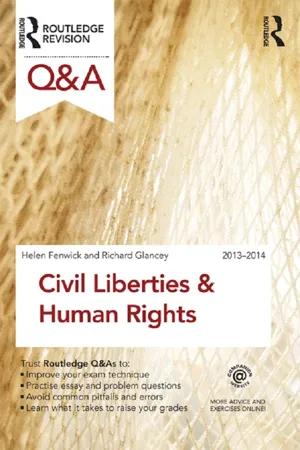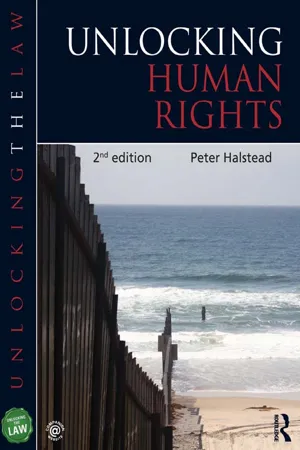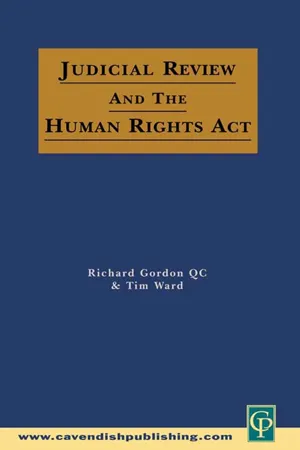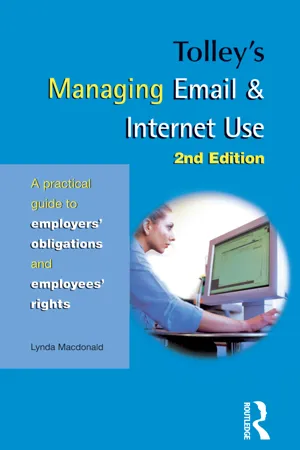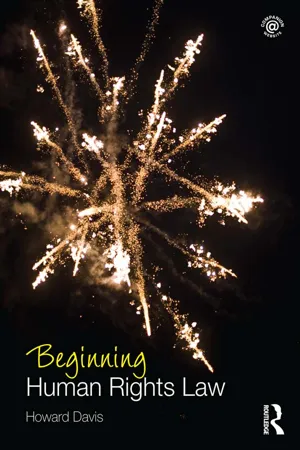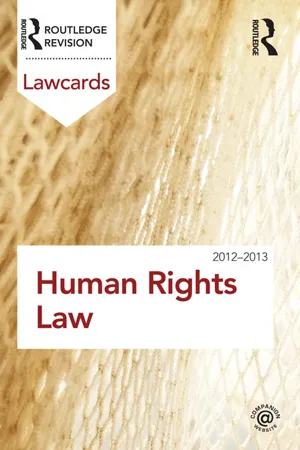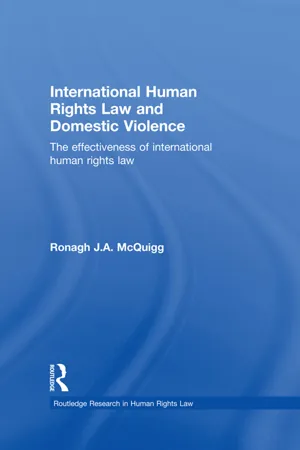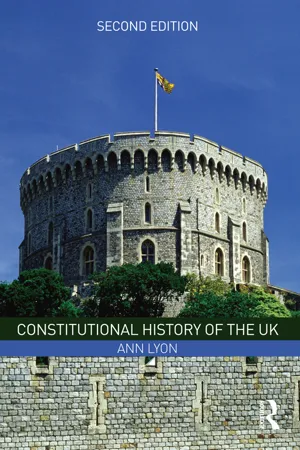Politics & International Relations
Human Rights Act 1998
The Human Rights Act 1998 is a UK law that incorporates the rights and freedoms outlined in the European Convention on Human Rights into domestic legislation. It allows individuals to enforce their human rights in UK courts and requires public authorities to act in a way that is compatible with these rights. The Act has had a significant impact on the protection of human rights within the UK legal system.
Written by Perlego with AI-assistance
Related key terms
9 Key excerpts on "Human Rights Act 1998"
- eBook - ePub
- Helen Fenwick, Richard Glancey(Authors)
- 2013(Publication Date)
- Routledge(Publisher)
8 The Human Rights Act 1998 and the European Convention on Human Rights INTRODUCTION The Human Rights Act (HRA) 1998 has at the time of writing been in force for over fifteen years (it came into force in 2000), so it is possible to make an interim but fairly tentative assessment as to its efficacy in protecting human rights and freedoms in the UK. It affords further effect to a number of the rights protected under the European Convention on Human Rights. It remains a controversial piece of legislation; for example, in 2006 parts of the media blamed it for weakening the UK in its ‘war’ against terrorism, and for the early release of criminals. The criticism was misleading, since even if the HRA was repealed, the UK would remain bound at international level to abide by the European Convention on Human Rights. The Conservative Party has stated that its policy is to repeal the Act and to replace it with a ‘modern British Bill of Rights’, and indeed, in March 2011 it established the Commission on a Bill of Rights to specifically look into this matter. It is not possible at the time of writing to confidently predict what the conclusions of the Commission are going to be. One key difficulty preventing this is that its terms of reference were vague, merely saying they have been charged to investigate the creation of a Bill of Rights that incorporates and builds on the UK’s obligations under the European Convention on Human Rights, ensures that these rights continue to be enshrined in UK law, and protects and extends liberties. Their terms are therefore very vague and generic, which merely raises more questions than it is possible to answer at this moment in time - eBook - ePub
- Richard Glancey(Author)
- 2014(Publication Date)
- Routledge(Publisher)
3 The Human Rights Act 1998 INTRODUCTIONThe Human Rights Act 1998 (HRA) does not provide the only means of protecting human rights and liberties in the UK, but it is the central piece of legislation in the field. The Act has now been in force for 14 years (it came into force in 2000), so it is possible to make an interim assessment as to its efficacy in protecting human rights and freedoms in the UK. It affords further effect to a number of the rights protected under the European Convention on Human Rights (ECHR) . It remains a controversial piece of legislation; for example, in 2006, in a distorted and misleading fashion, parts of the media blamed it for weakening the UK in its ‘war’ against terrorism, and for the early release of criminals. Prior to the 2010 general election the Conservative Party stated that its policy was to repeal the Act if a Conservative Government was elected, and to replace it with a ‘British Bill of Rights’. Once the current Coalition Government was in place, this policy became problematic since the Liberal Democrats were pledged to retain the HRA . An independent Commission was appointed to examine the possibility of repealing the HRA and introducing a Bill of Rights in its place. The intention appears to be to ensure that a new Bill of Rights provides as much protection for human rights as the HRA does. It is likely that there will be a long period of consultation before such a Bill of Rights is put in place. If – which remains a matter of doubt – eventually a Bill of Rights is enacted, it would presumably protect the Convention rights that are currently protected under the HRA , so the respect in which it would sharply differ from the HRA is currently unclear. It might be made weaker than the HRA in certain respects – for example, s 3 HRA might be reproduced in the new statute, but modified to discourage judges from taking a radical approach to rendering statutory provisions compatible with Convention rights through creative interpretation. It is also possible that s 2 HRA - eBook - ePub
- Peter Halstead(Author)
- 2014(Publication Date)
- Routledge(Publisher)
3 Human Rights Act 1998 AIMS AND OBJECTIVES At the end of this chapter you should be able to:Appreciate why there was a long time gap before the right of individual petition was made available in the United KingdomUnderstand how traditional civil rights under English law have substantially been translated into modern human rightsExplain how the European Convention is given ‘further effect’ in UK domestic lawDemonstrate how European case law influences English lawUnderstand how the substantive rights are interpreted by UK courtsAppreciate that the doctrine of parliamentary sovereignty is preserved whilst at the same time the influence of the superior courts is enhanced3.1 IntroductionThe Human Rights Act 1998 is one of the most important pieces of legislation enacted by Parliament in recent years and the key to understanding why that is, and how it operates, lies in the Council of Europe and the establishment and operation of the ECnHR discussed in Chapter 2 .The first part of this chapter examines the background and considers various reasons why the Convention was not made part of UK domestic law when it was ratified by the UK on 8 March 1951. Growing pressure over the years eventually led to the Convention being ‘brought home’ by the 1998 Act, which came into operation on 2 October 2000 although by virtue of the Scotland Act 1998 the Convention was already operative in Scotland. The chapter goes on to provide a detailed analysis of the Act and how it operates, discussing the substantive sections and schedules together with examples of relevant case law.3.1.1 A proud English traditionIt took almost half a century for the Convention to become directly accessible as of right to individuals in the United Kingdom once all domestic routes had been exhausted and there are various suggestions as to why this was the case, some more convincing than others. As explained in Chapter 2 - eBook - ePub
- Richard Gordon, Tim Ward(Authors)
- 2013(Publication Date)
- Routledge-Cavendish(Publisher)
Chapter 1 The Human Rights Act
DOI: 10.4324/9781843140368-11.01 The central theme of this book is the relationship between the Human Rights Act 1998 and public law.1.02 This chapter provides an overview of the Act and a general discussion of the problems that it raises. In some instances, where a more detailed exposition is provided elsewhere, cross-references are given.1.03 The text of the Act itself is set out in Appendix 1, p 233.Introduction
1.04 The preamble to the Human Rights Act states that its purpose is to ‘give further effect to the rights and freedoms guaranteed under the European Convention on Human Rights' (emphasis added). On its face, the Act allows the raising of Convention issues to be raised only by the ‘victim’ of the unlawful acts (or proposed acts) of a public authority.1 Ordinarily, such acts would be challenged by way of judicial review. The scheme of the Act suggests, however, that the Convention will impact upon almost all types of litigation, including that between private parties, and will extend well beyond the confines of judicial review. It will revolutionise the Courts' approach to both statutory construction2 and development of the common law.31 HRA 1998, s 7(1), (3), (7). See paras 1.12–2.19.2 See Ibid, ss 3 and 6, at paras 1.23–1.38.3 See Ibid, ss 2 and 6, at paras 1.15–1.22.The Rights Incorporated
1.05 Section 1 of the Human Rights Act defines the term ‘Convention rights’. It provides: - eBook - ePub
- Lynda Macdonald(Author)
- 2009(Publication Date)
- Routledge(Publisher)
Essentially the Act gives private individuals the right to take a public authority to court if they believe that one of their rights, as defined in the Act, has been infringed by that authority. This means that employees of public authorities can take a direct claim against their employer in court or tribunal if any of their rights under the Act is infringed by the employer.Although the Act does not confer any similar benefit on private sector employees, there is a separate provision which obliges courts and tribunals (as public authorities themselves) to interpret legislation (including employment law) in such a way as is compatible with the rights contained in the European Convention (and by extension the Human Rights Act 1998). Thus private sector employers are affected, albeit indirectly.Claims brought directly under the Human Rights Act 1998 must be brought within one year of the date of the act complained of. Courts and tribunals do have discretion to extend that time limit if they believe it is equitable in all the circumstances to do so.The Human Rights Act 1998 – A Summary of the Act and its Inter–Relationship With Employment Law [7.3] The Human Rights Act 1998 contains a range of rights and freedoms for individuals as follows:Article 2: The right to life. Article 3: The right not to be subjected to torture or to inhuman or degrading treatment or punishment; Article 4: Prohibition of slavery and forced labour. Article 5: The right to liberty and security. Article 6: The right to a fair trial. Article 7: The right not to be punished without law (i.e. the right not to be held guilty of a criminal offence when none has been committed). - eBook - ePub
- Howard Davis(Author)
- 2014(Publication Date)
- Routledge(Publisher)
Chapter 3The Human Rights ActLEARNING OBJECTIVES
On completing this chapter the reader should understand:• The reasons for enactment of the Human Rights Act (HRA) 1998• The extent to which rights under the HRA will ‘mirror’ those available from Strasbourg• The impact of the HRA on the ‘separation of powers’ in the UK constitution• The nature of the duty, in s 3, to interpret legislation compatibly with Convention rights• The nature of the duty, in s 6, on public authorities• The role of Parliament in the HRA.INTRODUCTION
The Human Rights Act 1998 gives ‘further effect’ in UK law to the ‘Convention rights’ found in the European Convention on Human Rights (ECHR). It does this in two ways, which should always be borne in mind.• It requires, unless this is not possible, Acts of Parliament to be so interpreted that they can only authorise actions that are compatible with, consistent with, the human rights found in the ECHR (the ‘Convention rights’).• It places a legally enforceable duty on public authorities only to act in ways which are compatible with Convention rights.REASONS FOR ENACTMENT
The road to Strasbourg
The principal reason for enacting the HRA was to make available in UK courts the rights in the ECHR. Before the Act these ‘Convention rights’ were not part of the law of the UK. They were, though, influencing the way the law was developing and British people were bringing alleged violations before the European Court of Human Rights (ECtHR), often with success. Many thought it unfair that a person had to take his or her case to Strasbourg when UK law failed to provide an adequate remedy for a breach of human rights. Pressure from academics, politicians and senior members of the judiciary developed during the 1990s leading to some form of incorporation of the Convention being adopted by the Labour Party. The Party came to power in 1997 and enacted the legislation as part of a raft of other constitutional measures (such as devolution). - eBook - ePub
- Routledge(Author)
- 2013(Publication Date)
- Routledge(Publisher)
The Human Rights Act 1998Section 1 Incorporation of the Articles What Articles are omitted from HRA 1998? How have the courts interpreted the HRA? Positive and negative obligations Absolute and qualified rights Derogations This chapter looks in detail at the British ‘model’ of incorporation of the European Convention on Human Rights (ECHR) , as implemented by the Human Rights Act (HRA) 1998 . The chapter begins with the basic principles underlying the Act and then moves onto the most important sections of the Act, using illustrations where relevant.INTRODUCTION
As noted in Chapter 3 , the chosen approach to incorporation under the HRA 1998 is closer to the New Zealand model than the Canadian model. The Act adopts an ‘interpretative’ only approach and consequently the courts are not empowered to strike down incompatible primary legislation. The Lord Chancellor indicated that the intention was to learn from the experience of others but not to be constrained by it and that a ‘distinctively British approach for our British Parliament and British courts’ was to be adopted. There are a number of novel features in the British approach. The Lord Chancellor summed up the British model of incorporation as follows:The [Act] is based on a number of principles. Legislation should be construed compatibly with the Convention as far as is possible. The sovereignty of Parliament should not be disturbed. Where the courts cannot reconcile the legislation with Convention rights, Parliament should be able to do so - and more quickly if appropriate, than by enacting primary legislation. Public authorities should comply with Convention rights or face the prospect of legal challenge. Remedies should be available for a breach of Convention rights by a public authority. - eBook - ePub
International Human Rights Law and Domestic Violence
The Effectiveness of International Human Rights Law
- Ronagh J.A. McQuigg(Author)
- 2011(Publication Date)
- Routledge(Publisher)
4 The Human Rights Act 1998 Could the United Kingdom courts rise to the challenge?The previous chapter outlined the potential held by the case law of the European Court of Human Rights on positive obligations to contribute to the fight against domestic violence. Although there are limitations on this potential, nevertheless the European Court has developed jurisprudence that could be used beneficially in this area. Governments have been repeatedly reminded that not only must they refrain from violating human rights standards, they also have duties to take positive steps to ensure that the rights of individuals are protected effectively. The European Convention has been incorporated into UK law by the Human Rights Act 1998.1 However, could the UK courts rise to the challenge and use Convention rights to assist victims of domestic violence?This chapter will refer to the issues raised in Chapter 1 of the book. The issue of the public/private divide will be examined through a discussion of the horizontal effect of the Human Rights Act. The problem of conflicting rights is brought into focus by the difficulty of alleged perpetrators relying on human rights law. Problems surrounding the implementation of rights are highlighted by the issue of deference; the limits on what courts can achieve and difficulties surrounding socio-economic rights; and questions relating to the ability of law to deal with an ‘unseen’ crime. Essentially, the chapter will examine whether the UK courts could use the Human Rights Act to achieve the three categories of measures that are most highlighted by commentators in the UK as being necessary in the area of domestic violence – improvements in the criminal justice system, the provision of social support measures for victims, such as refuge accommodation, and the implementation of awareness raising programmes (see Chapter 2). - eBook - ePub
- Ann Lyon(Author)
- 2016(Publication Date)
- Routledge(Publisher)
28 The European Convention on Human Rights and the Human Rights Act 1998Overview
- The development of universal human rights
- The European Convention on Human Rights
- Britain and the convention before the Human Rights Act
- The Human Rights Act
- A British Bill of Rights?
28.1 Introduction
The European Convention on Human Rights, incorporated into the law of Scotland and Northern Ireland by their respective devolution Acts, and that of the UK as a whole under the terms of the Human Rights Act 1998, is in its origins and provisions very much a product of the world as it was in the immediate aftermath of the Second World War.In 1945 and soon after, full details emerged of the actions of the Nazi regime which held power in Germany from 1933 and occupied much of Europe in 1939–45. There was a deep sense that such abuses must never be allowed to happen again. In addition to a policy of genocide which resulted in the systematic liquidation of some six million Jews, the Nazis disposed of smaller but significant numbers of gypsies, disabled and mentally handicapped persons and homosexuals as part of a policy of purging the population of its ‘undesirable’ elements. In addition, they executed or imprisoned large numbers of ideological opponents and sought to eliminate all opposition. From the 1930s, the Soviet regime also pursued active policies of repression towards political enemies. A largescale ‘purge’ of the Communist Party and national institutions took place in the years 1937–40 and a system of labour camps falling outside the normal criminal justice system was created, for which the writer Alexander Solzhenitsyn – who himself spent eight years in a labour camp after criticising the dictator Stalin – coined the name ‘Gulag Archipelago’.Although the Nazi government had been destroyed, in the late 1940s the Soviet regime was extending its power over much of eastern Europe. In this period, several international organisations were formed in Europe and elsewhere with the intention of establishing and maintaining democratic government and institutions, and encouraging member states to resolve their differences by peaceful means. Among these was the Council of Europe, formed by the governments of 25 states with the broad aim of fostering democratic government within western Europe.
Learn about this page
Index pages curate the most relevant extracts from our library of academic textbooks. They’ve been created using an in-house natural language model (NLM), each adding context and meaning to key research topics.
